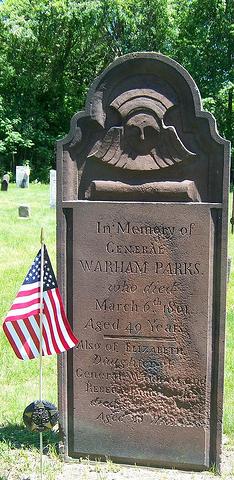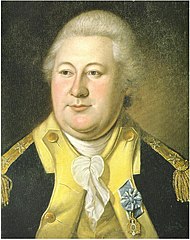On 24 May 1776,
Dr. Isaac Foster of the
Continental Army discovered that
Dr. Azor Betts had inoculated four officers against
smallpox, and also against Gen.
George Washington’s orders.
Those men were identified in the commander’s papers as “Lt Colonel Moulton, Capt. Parks, Doctor Hart and Lieut. Brown.”
It might be no surprise those all appear to be Massachusetts officers. Not only did Massachusetts supply the bulk of the Continental Army in early 1776, but its officers still tended to follow their own counsel.
Lt. Col.
Johnson Moulton (d. 1793) came from York in the district of
Maine. He gained the rank of captain during the
French and
Indian War, and on 21 Apr 1775 he led a
militia company south toward Boston. When he and those men returned home after four days, Moulton discovered that
James Scamman had already started to recruit a regiment from the area, which proceeded to the
siege of Boston.
In May, Moulton presented Gen.
Artemas Ward with a letter from some neighbors suggesting he should be colonel and Scamman his second-in-command. Instead, the
Massachusetts Provincial Congress went with Col. Scamman and Lt. Col. Moulton. Then Scamman behaved embarrassingly at the
Battle of Bunker Hill. Though acquitted of the charge of “backwardness,” he left the Continental Army at the end of the year.
Moulton remained with the army, but he also remained a lieutenant colonel, assigned to the 7th Continental Regiment under Col.
William Prescott. Immediately after the British evacuated Boston, Washington ordered that regiment to head to
New York and start fortifying the city. On 7 April they were assigned to build breastworks on Governor’s Island.
(There was another lieutenant colonel named Moulton in the New York campaign: Stephen Moulton of Stafford,
Connecticut,
captured at White Plains. But in May he was representing his town in the Connecticut assembly, so he couldn’t have been getting inoculated in New York.)
Warham Parks (1752–1801) of
Westfield and the
Harvard College class of 1773 was a captain in Col.
Ebenezer Learned’s 3d Continental Regiment. He became a major in the 4th Massachusetts Regiment at the start of 1777.
After being wounded at the Battle of
Saratoga, Parks resigned his commission the following March. Washington
personally asked him to remain, but he replied, “I am bound in Conciense & honor to Resign my Small Command to those who have health of Body & firmness of mind Sufficient to Carry them through the hardship and dangers of a Soldiers Life.”
Parks returned to his home town, married, and started to win elected and appointed offices. In 1782 he became the brigadier general of the Hampshire County militia and also presided over the court-martial that Col.
Paul Revere requested after the
Penobscot expedition. His second wife was a daughter of
Nathaniel Gorham, president of the
Continental Congress in 1786.
Parks’s grave marker appears above.
Dr. John Hart (1751–1836) was born in
Ipswich and moved to Maine for
medical training and his early practice. He became surgeon in Col. Prescott’s regiment in May 1775 and served in that and other Continental regiments until June 1784. After the war he settled in
Reading, served in the state senate, and was active in the Massachusetts
Society of the Cincinnati.
(Again, it’s possible this patient was Dr. Josiah Hart of Connecticut instead, but the surgeon in Prescott’s regiment seems more likely.)
As for “Lieut. Brown,” that man is impossible to identify with certainty. As of January 1776 Prescott’s regiment contained:
-
1st Lt. Benjamin Brown (1745–1821) of Myrifield (later incorporated as Rowe), who later became a captain and served until July 1779.
-
1st Lt. Joshua Brown (1742-1817) of Stow, a veteran of the last war and another captain until mid-1779.
-
2nd Lt. Samuel Brown (1752-1819) of Concord. (Not be confused with Lt. Samuel Brown [1749-1828] of Acton, who was a prisoner at Québec at this time.)
What does identifying those men tell us about their choice to inoculate? First, most of them (or all, if the lieutenant was Benjamin Brown) came from parts of Massachusetts remote from Boston. They were thus less likely to have been exposed to smallpox or had a chance to be inoculated against it.
Second, these were officers, not enlisted men. One was a second-in-command of a regiment. Another was a doctor himself. They had all reenlisted in the Continental Army and would continue to serve on many campaigns. They were clearly committed to the cause. There’s little doubt they sought inoculation so as to be more useful for the army, not less.
Third, none of these four men died from the inoculation. At the end of June they were healthier than before.
Finally, and perhaps most important, there’s no record that these men were punished for convincing Dr. Betts to inoculate them. Some were promoted in the next couple of years. Gen. Washington even asked one to remain in the army. Even though they had disobeyed the commander-in-chief’s order, the commander-in-chief appears to have forgiven them.
TOMORROW: Who took the blame.





